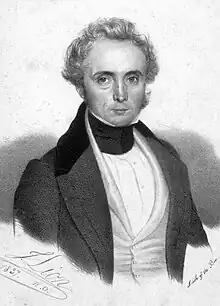William Newton Mercer | |
|---|---|
 William Newton Mercer | |
| Personal details | |
| Born | 1790 Cecil County, Maryland, US |
| Died | August 16, 1874 (aged 83–84) New Orleans, Louisiana, US |
| Spouse |
Ann Eliza Farar
(after 1823) |
| Relations | Stephen Duncan(uncle) |
| Children | 2 |
| Education | University of Virginia, University of Pennsylvania School of Medicine |
| Occupation | Surgeon & Planter |
William Newton Mercer was a surgeon and prominent civic leader in New Orleans during the nineteenth century. His residence later became the headquarters of the Boston Club, which has been associated with the history of business and Carnival in New Orleans.
Early life
William was born in Cecil County, Maryland, in 1790.[1] He studied medicine at The University of Pennsylvania School of Medicine under Benjamin Rush. He then served as a surgeon for United States Army during the War of 1812, stationed in New Orleans, Louisiana, then Natchez, Mississippi, before resigning there into private practice.
Career

In Mississippi, Mercer owned four plantations in Adams County—Laurel Hill, Buckhurst, Ellis Cliffs, and Ormond—and property in Coahoma County.[2] Mercer owned 342 slaves, and was the twelfth largest slave owner in the state.[3] Mercer also owned property in Illinois and New Orleans.[2] He utilized Charles P. Leverich as a factor.[4]
He served as president of the Bank of Louisiana,[5] trustee at Natchez Academy, and president and chairman of the Board of Administrators of the University of Louisiana. He was a member of Christ Church Cathedral and president of St. Anna’s Asylum in New Orleans.[6]
Philanthropy
Mercer was the President of the Board of University of Louisiana under with Secretary Albert G. Blanchard, Chief Justice of the Louisiana Supreme Court Edwin T. Merrick, Mayor of New Orleans Charles M. Waterman (politician), Admin Pierre Emile Bonford, Admin. Edmund Jean Forstall, and Admin Isadore Labatut, M.D..[7]
Personal life
In 1823, Mercer married in Natchez, Ann Eliza Farar, daughter of Benjamin Farar and Mary Ellis, heiress of Richard Ellis, the original recipient of the Royal Spanish land grant of 20,000 ha (49,000 acres), including Ellis Cliffs, Mississippi, and Laurel Hill Plantation in Adams County, Mississippi.[8][9] The family resided at their Laurel Hill Plantation in Adams County, where Mercer built St. Mary's Episcopal Chapel.[10] His wife's brother's daughter, Margaret Ellis, married Stephen Duncan.
Mercer died in New Orleans at age 83.[1]
References
- 1 2 "William Newton Mercer obituary". The Times-Picayune. New Orleans. August 18, 1874. p. 4 – via newspapers.com.
- 1 2 Berlin, Ira (2003). Records of Southern Plantations from Emancipation to the Great Migration (PDF). Louisiana State University Libraries.
- ↑ Scarborough, William Kauffman (2006). Masters of the Big House, Elite Slaveholders of the Mid-Nineteenth-Century South. LSU Press. p. 446. ISBN 9780807131558.
- ↑ Scott P. Marler, The Merchants' Capital: New Orleans and the Political Economy of the Nineteenth-Century South, Cambridge, England: Cambridge University Press, 29 Apr 2013, p. 110
- ↑ "Enslaved servant's coat on loan to the Met helps tell "unfinished stories about American fashion" | the Historic New Orleans Collection".
- ↑ Report of the Board of Administrators of the insane asylum Archive.org
- ↑ East Louisiana State Hospital (1857). Report of the Board of Administrators of the insane asylum at Jackson to the legislature of the state of Louisiana. OCLC 1052543850.
- ↑ Ellis Farrar Papers lsu.edu
- ↑ Farrar (Benjamin) Papers lsu.edu
- ↑ Gomez, Kelly (November 26, 2017). "Remarkable Chapel in the Mississippi Woods -".